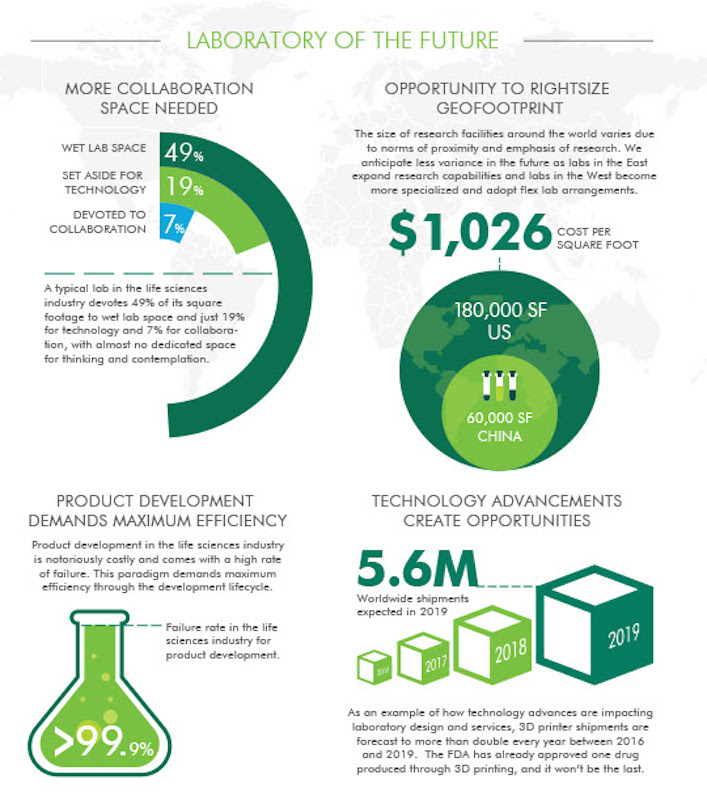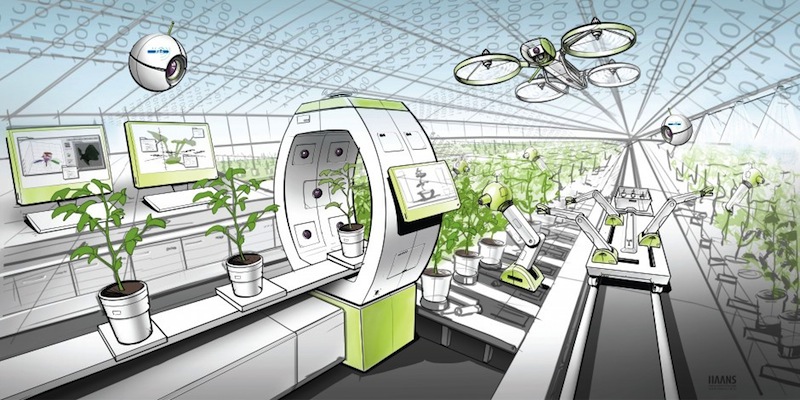Lab design has failed to keep pace with scientific advances and the changing needs of researchers. If, as expected, the next generation ushers in significant revolutions in the ways science is conducted, then lab design and operations, and the ways that scientists interact with these environments, will be at the heart of this change.
That is the scenario CBRE Global Workplace Solutions lays out in a just-released report, “Lab of the Future,” authored by Gregory Weddle, CBRE’s Vice President of Innovation and Products; and Hannah Hahn, its Global Workplace Innovation Manager.
The report draws heavily from a benchmarking study of labs that CBRE completed in 2014, which collected data from 24 labs in three global regions across four leading pharmaceutical companies. The report also reflects more than 68 lab professionals who responded to a questionnaire and contributed qualitative data on occupancy, instrumentation, spatial use, and collaborative space.
There are several reasons why labs need fresh design approaches. The era of the blockbuster drug discovery is past, and long-term trends lean toward personalized care, data-driven discovery, and digitization of lab spaces. “Hyper-flexible spaces that can be reconfigured as needs change will become more important.”
In addition, R&D is moving to lower-cost countries and to be closer to new markets. By 2025, two thirds of the world’s population could be living in Asia. Per-capita health spending in these markets today is significantly below Western levels. “The ability to collaborate quickly and efficiently among global locations will be more vital than ever.”
Indeed, CBRE sees organizations placing far more emphasis on speed to market and maximizing the use cost for their research facilities. “There is intense scrutiny on the return on investment for all R&D projects.”

Future labs need to be adaptable to changing technologies, and be set up to deliver products quicker to market. Image: CBRE Global Workplace Solutions
CBRE says that, at the very least, organizations with lab space should be asking themselves:
• Does your organization have many large molecule products in its pipeline?
• Is your science focus changing?
• Is your organization well-funded?
• Is your organization able to attract the scientists it requires in timely fashion?
• How willing is my organization to adopt new processes?
“Business strategy, therefore, must drive laboratory strategy,” CBRE concludes.
Among the trends that the CBRE’s report cites include digital lab space, which reflects the new generation of researchers known as digital natives, who are accustomed to digital technology having grown up with it. Social technology is changing communication patterns within labs, leading to flatter structures based on specialty interests. And given that only 7% of current lab space is set aside for collaboration, future labs must allocate more area for researcher collaboration, enabled by technology and design concepts.
Standardization could be a key to making labs more efficient and amenable, says CBRE. “Modular planning principles will be used to create a collaborative, flexible lab floorplan that can be used as a rotating lab,” the report states. “This means each lab space must be essentially the same size to allow for changes in lab furniture, bench space and overall layout. Today’s (and tomorrow’s) labs are aided by the ability to prefabricate building elements.”
Other factors influencing the shifting utilization of lab space include the miniaturization of equipment, which has been going on for a while, and helps to make researchers more productive in less floor space. Automation and robotics, so-called “shy” technology that’s barely noticeble (such as devices that communicate with each other), 3D printing, and artificial intelligence will all play roles in lab design and space utilization.
CBRE points out that, as life sciences become more technologically focused, labs must be set up to handle the greater volumes of data. Currently about 20% of lab space is set aside for technology, and that will need to increase significantly over the next 25 years.
And adept, skilled facilities managers will be in demand to keeping labs functional. “Put simply, as the physical location of the lab and all of its equipment become more fluid, a team that keeps track of utilization, operation, and maintenance of equipment will play an important role,” the report states.
Related Stories
Laboratories | Oct 23, 2024
From sterile to stimulating: The rise of community-centric life sciences campuses
To distinguish their life sciences campuses, developers are partnering with architectural and design firms to reimagine life sciences facilities as vibrant, welcoming destinations. By emphasizing four key elements—wellness, collaboration, biophilic design, and community integration—they are setting their properties apart.
Laboratories | Oct 2, 2024
Trends in scientific research environments: Q&A with Flad's Matt McCord
As part of an ongoing series, Matt McCord, AIA, NCARB, LEED AP BD+C, Associate Principal with Flad Architects, discusses the future of the scientific workplace.
Laboratories | Sep 27, 2024
Traditional lab design doesn't address neurodiverse needs, study finds
A study conducted by ARC, HOK, and the University of the West of Scotland, has revealed that half (48.1%) of all survey respondents who work in laboratory settings identify as neurodivergent.
Laboratories | Sep 26, 2024
BSL conversions: A cost-efficient method to support high-containment research
Some institutions are creating flexible lab spaces that can operate at a BSL-2 and modulate up to a BSL-3 when the need arises. Here are key aspects to consider when accommodating a rapid modulation between BSL-2 and BSL-3 space.
Higher Education | Sep 18, 2024
Modernizing dental schools: The intersection of design and education
Page's John Smith and Jennifer Amster share the how firm's approach to dental education facilities builds on the success of evidence-based design techniques pioneered in the healthcare built environment.
Great Solutions | Jul 23, 2024
41 Great Solutions for architects, engineers, and contractors
AI ChatBots, ambient computing, floating MRIs, low-carbon cement, sunshine on demand, next-generation top-down construction. These and 35 other innovations make up our 2024 Great Solutions Report, which highlights fresh ideas and innovations from leading architecture, engineering, and construction firms.
Laboratories | Jul 3, 2024
New science, old buildings: Renovating for efficiency, flexibility, and connection
What does the research space of the future look like? And can it be housed in older buildings—or does it require new construction?
Mass Timber | Jun 26, 2024
Oregon State University builds a first-of-its-kind mass timber research lab
In Corvallis, Oreg., the Jen-Hsun Huang and Lori Mills Huang Collaborative Innovation Complex at Oregon State University aims to achieve a distinction among the world’s experimental research labs: It will be the first all-mass-timber lab meeting rigorous vibration criteria (2000 micro-inches per second, or MIPS).
Healthcare Facilities | Jun 18, 2024
A healthcare simulation technology consultant can save time, money, and headaches
As the demand for skilled healthcare professionals continues to rise, healthcare simulation is playing an increasingly vital role in the skill development, compliance, and continuing education of the clinical workforce.
Laboratories | May 24, 2024
The Department of Energy breaks ground on the Princeton Plasma Innovation Center
In Princeton, N.J., the U.S. Department of Energy’s Princeton Plasma Physics Laboratory (PPPL) has broken ground on the Princeton Plasma Innovation Center (PPIC), a state-of-the-art office and laboratory building. Designed and constructed by SmithGroup, the $109.7 million facility will provide space for research supporting PPPL’s expanded mission into microelectronics, quantum sensors and devices, and sustainability sciences.

















